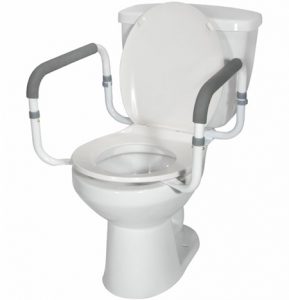A handicap bathroom is just another way of saying that the room has been modified to make it safe and functional for persons with a disability or mobility issues. The specific modifications needed to make a disabled bathroom fully accessible depend on the person and their exact needs. However, here are some general tips to create a handicap bathroom that is accessible and able to accommodate most needs.
Disabled Bathroom Renovation Suggestions
#1. Install Grip Bars Adjacent to Toilet

Transferring from a stroller or wheelchair can be dangerous. To reduce the risk for injury and falls, specially engineered grip bars need to be installed. For maximum safety, install a safety bar on both sides of the toilet about 1.5m apart (depending on arm span of the user). However, some specially made toilets have the hand rails built-in to avoid issues with mounting rails to the wall.
#2: Replace Conventional Toilet with Wall-Mounted or Extra-Tall Toilet
Getting up off the toilet from a seated position can be difficult for the disabled and elderly. A tall or wall-mounted toilet is higher off the ground than a conventional commode. This not only reduces unnecessary bending, but also makes it safer for persons in wheelchairs or walkers to transfer.
#3. Add Safety Rails to Shower or Tub Area
Slips and falls in the tub or shower area are the most common injuries reported in the bathroom. So for a disabled bathroom to be fully functional, safety rails need installed in the tub or shower area. For tubs, two safety grips should be installed at the point of entry. One grip should be accessible while sitting and the other while standing. The placement of these two safety grips is vital to ensuring a safe transfer in and out of the tub.
For enclosed showers, a safety grip on all three walls (not side with door) is highly recommended. And to ensure safety, all grip bars in a handicap bathroom should be installed by professionals. These safety bars must not move while in use and must be mounted to the studs behind the wall.
#4. Install Bath or Transfer Bench
If the bathroom needs to be wheelchair accessible and has a tub, then a transfer bench will be needed. A transfer or bath bench allows the user to enter and exit the tub without stepping over the side wall. One end extends out over the floor for access and then the person simply slides to the tub end and climbs in. Professional installation of the bath bench is recommended because it must not slide or move while in use.
#5. Install Hand Held Sprayer, Non-Slip Flooring and a Shower Chair
To improve disabled shower accessibility, a few safety features will be needed. To avoid falling on slippery shower tiles, install non-slip flooring. For a safe place to sit and bathe, a non-slip shower chair is vital to disabled shower accessibility. And to safely bathe while sitting in the shower chair, you’ll need to strategically place and install a hand held sprayer.
In addition to the general tips listed above, a handicap bathroom might also be equipped with special vanities that allow for full wheelchair access. Shower safety gates also improve safety for the elderly and disabled with walk-in showers. Safety drain covers are essential safety features in bathrooms where walkers or canes are used. Lastly, specially designed hands-free sinks may be used to increase bathroom accessibility for persons with wheelchairs or severe mobility limitations.
Accessable Bathrooms is Perth’s exclusive disabled bathroom modification experts. We can modify most existing bathrooms to make them completely accessible to suit your exact needs and budget. We provide a Free Safety Audit and 3D design to show you exactly how your newly accessible bathroom will look when complete.
